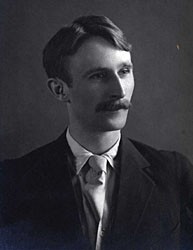
Student Project Reveals Rare UC Research Collection
A history of two activist brothers from Cincinnati has evolved into one of the most researched labor collections in the United States, and its housed in the Archives and Rare Books Library at the University of Cincinnati. Now that history, along with images and a full inventory of the
James B. and John J. McNamara collection, can be found online.
Kevin Grace, head of Archives and Rare Books, says the McNamara brothers story evolved into an international labor cause and as a result, Grace says the collection had drawn the attention of labor activists, scholars of socialism and labor movements, writers and even researchers for television and film.
The online exhibit was researched and created by 22-year-old Eira Tansey of Clifton, Ohio. Tansey, a geography major whos interested in pursuing a graduate degree in library science, is a student worker in the UC Archives and Rare Books Library and is also a student in the University Honors Program. I found that one of the challenges in designing the online exhibit was figuring out exactly what to include. This is such a vast collection. Also, I wanted to make sure the online exhibit objectively told their story, Tansey says.

John J. McNamara
Born in Cincinnati, the McNamara brothers became union activists for the International Association of Bridge and Structural Iron Workers at the beginning of the 20th century. John J. McNamara served as secretary-treasurer of the iron workers union. Tansey says the brothers and accomplices were accused of masterminding attacks on open-shop business, industries and construction companies that had either resisted unionization or engaged in union-busting tactics. James B. McNamara and accomplices were accused of setting up the dynamite in some of the attacks, which included targeting a series of bridges under construction in cities that included Cincinnati and Cleveland.
However, the online exhibit reveals it was the 1910 bombing of the Los Angeles Times building, killing 21 people, which led to their arrests. L.A. Times owner Harrison Gray Otis, an outspoken opponent of organized labor, suspected the labor movement in the attack outside the L.A. Times building.
In December, 1911, with both brothers taking a plea bargain and avoiding trial, James B. McNamara pleaded guilty to first-degree murder after an accomplice named him in connection with the attack. John J. pleaded guilty to conspiracy in the dynamite bombing of the Llewellyn Iron Works. James B. received a life prison sentence, and John J. was sentenced to 15 years in prison (serving 10 after receiving parole). Both brothers died in 1941.
Tansey says the players and circumstances surrounding the court case are what bring this history such fame. Defense attorney Clarence Darrow, who helped spare the brothers from the death penalty, was most famous for representing Tennessee science teacher John Scopes when Scopes was prosecuted for teaching evolution. The case also caught the attention of Lincoln Steffens, whos called one of the pioneers of muckraking journalism.
Samuel Gompers, one of the founders of the American Federation of Labor, initially believed the brothers were framed in a conspiracy against organized labor and hired Clarence Darrow to defend them. Job Harriman, who was hired for the defense, was running as the Los Angeles Socialist candidate for mayor during the court case. The online exhibit created by Tansey carries brief biographies on all of those activists who were involved with the court case.

Eira Tansey
I learned quite a bit about labor history from that time, as well as about the personalities involved in the case, Tansey says. I only knew of Clarence Darrow from the Scopes Monkey Trial, but I discovered he had a long and illustrious career. I was also interested in the biography of Lincoln Steffens, she says.
The exhibit also features highlights of whats contained in the McNamara archives collection, including correspondence (such as letters from the brothers and letters to James B. McNamara from writers Upton Sinclair and Irving Stone), legal documents, magazine and newspaper clippings and photos taken by James B. McNamara when he was serving his sentence in San Quentin Prison.
Because of all of the people involved with the trial, it became an international news story, explains Grace. The UC collection has had a great deal of use over the decades.
Related Stories
The 2024 Toast recognizes achievements of Lindner’s Business...
April 25, 2024
The Carl H. Lindner College of Business Office of Inclusive Excellence hosted its annual Toast event for the Business Fellows program April 18 at The Graduate Hotel Cincinnati.
2024 Daniel Drake Medals to be awarded April 27
April 24, 2024
The UC College of Medicine will award three people with 2024 Daniel Drake Medals April 27.
UC education allowed couple to make mark on Cincinnati
April 24, 2024
As a native of Defiance, Ohio, John Deatrick, CEAS ’79, says arriving in Cincinnati to attend the University of Cincinnati in 1963 felt like landing in New York City.
